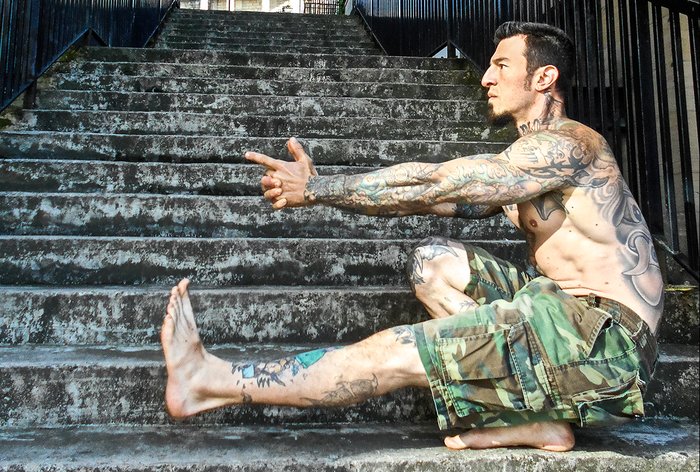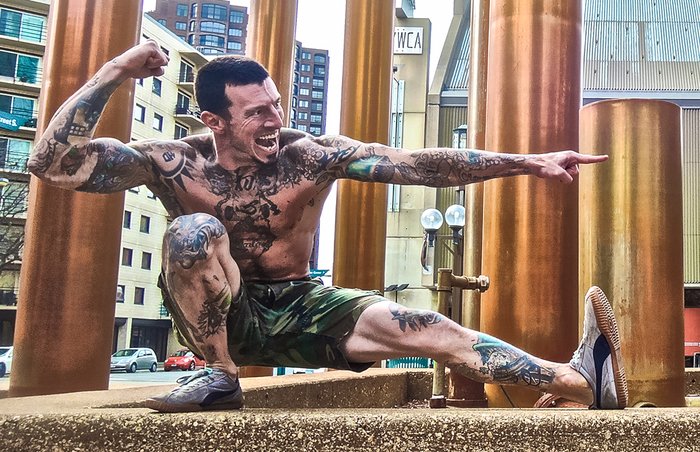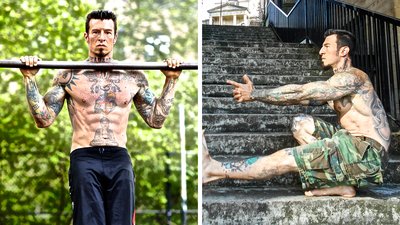Think the only way to get strong and jacked is by adding more external resistance to an exercise? I used to think so, too. I'd hit the bench, the bar, and the leg press, consistently adding poundage, just like I was told to. Between lengthy work sets and extended recovery time, I spent a lot of hours performing a relatively low amount of exercise.
Well, not anymore. While there is certainly nothing wrong with heavy resistance training—and there is no doubt that it can yield fantastic results—it's far from being the only system. With these four techniques, you will learn to employ physics—the motion-and-force kind, not the quark kind—to seek and destroy your fitness goals.
The best part? These methods require minimal equipment and no gym membership, as they employ adjustments in technique, not external load.
1. Increase The Range Of Motion
When you want to make something more difficult, adding a 5-pound plate to the bar or lowering the pin on a weight stack one notch aren't the only choices. Simply increasing the range of motion of a given exercise will give you greater yields for every rep.
For example, try squatting all the way to the ground, until the back of your thigh comes into complete contact with your calf. You could be selling yourself short when you stop with your thigh parallel to the ground, as many coaches recommend. The same with your push-ups: Get down there close to the ground, and then push up all the way to where your elbows lock out and your shoulder blades spread! The human body was built for the full motion, even if you haven't been doing it.

Finger Push-Up
To get the most out of a pull-up, start from a full dead hang at the bottom position. Now pull your chest all the way to the bar—don't stop at the chin. Get high! You'd be amazed by how many people I see performing weighted pull-ups with a limited range of motion. By increasing the distance traveled, you progress the exercise dramatically without having to depend on anything but yourself. Sure, the number of reps you can perform will go down, but the strength-building stimulus your body receives will go way up.
By the same token, performing push-ups on your fingertips or knuckles not only provides a unique challenge to your hands and forearms, it also allows you to get lower than when you use your palms. Give any of these a try, and you'll see exactly what I mean.
2. Do Something More Difficult
This one sounds like a no-brainer, but it's not exactly what you think. Oftentimes, we tend to think in terms of specific exercises rather than movement patterns. However, when you step back from a particular exercise and just focus on what your body is doing spatially—"horizontal push" as opposed to push-up, or "vertical pull" rather than chin-up—you can increase the resistance by doing the same movement pattern in a slightly different exercise. This alters the amount of weight distributed to a particular body part or muscle group, often in a way that humbles you immediately.
This is why a single-leg pistol squat will always require more strength than a standard squat. By eliminating one point of contact, you double the body weight loaded on to the individual leg. Fortunately, there are many steps in between the two, such as the archer squat or Bulgarian split squat. Both of these are self-assisted single-leg squats that offer an increased weight-to-limb ratio.

Pistol Squat
Manipulating leverage is also an effective tool. To understand this, compare a push-up with your feet on an elevated surface to a push-up with all limbs on the ground. There is much more weight on the chest, arms, and shoulders in the former than in the latter, due to the change in leverage. It's the same reason that a straight-leg raise is more difficult that a bent-knee raise. Your body weight may not change, but the challenge the move presents definitely does.
3. Slow It Down
How many times have you been at the gym and seen someone repping out, rep after sloppy rep, completely overlooking quality of movement, so they can hit a certain number of reps? It's probably...every time you've ever been to the gym.
While the advocacy of putting numbers above all else is a sad, sad shame, it comes as no surprise. After all, we live in a culture of "more is more." Everyone wants to do as many reps as possible, even if most of those reps wouldn't even qualify as one to a discerning trainer's eye.

Sit Up
The truth is, if you want to squeeze maximal resistance out of every single set, you have to take it slow. The simple change in tempo will add more tension to every rep and set, increasing the amount of muscle fibers being fired up.
I'm not referring to "super-slow" training either—that's something different. I'm simply talking about quality, controlled movements through a full range of motion, devoid of swinging or bouncing. This not only promotes pure strength, but also neurologically wires in proper form, allowing you to get more out of every move, from the humble sit-up to the mighty muscle-up!
4. Improve Your Technique
"How do I get to Carnegie Hall?" asks the old joke. The answer, of course, is practice.
Well, advanced exercise moves can be practice too. I couldn't begin to tell you how many times I've been asked, "What's the next progression after you can do a muscle-up?" My answer: "Do a clean muscle-up."
The first step to doing something well is often just to get it done, but that's definitely not the final step.

Archer Squat
You see, nobody's first muscle-up is their best one. Neither is their first single-arm push-up, elbow lever, or pistol squat. After you get that first one, you need to get it better. I refer to this as "technical progression" which involves increasing the difficulty of an exercise without ever adding weight.
What comes after your clean muscle-up? Get more air. What comes next? Add a clap. When you improve and progress your technique over time, the sky is the limit!

